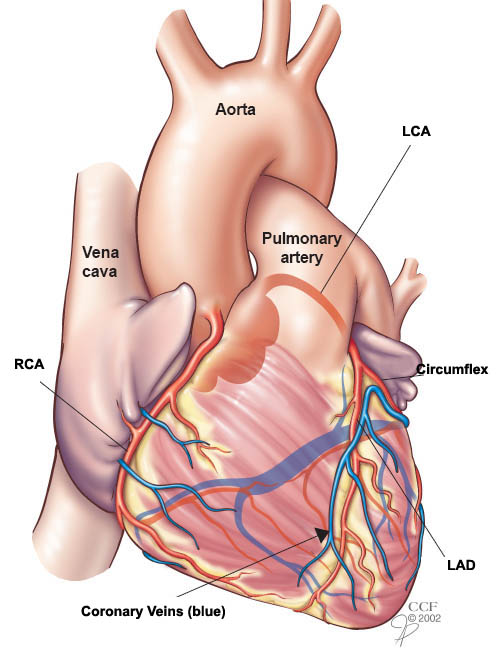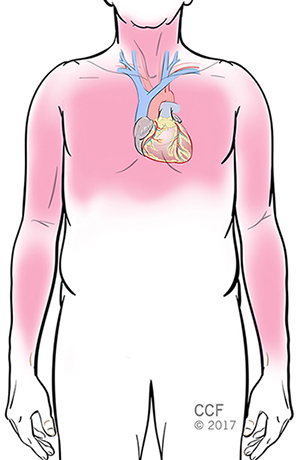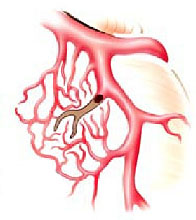what term is used to identify when a cell is temporarily deprived of blood supply?
Overview

What is coronary artery illness?
Coronary artery disease is a narrowing or blockage of your coronary arteries commonly caused by the buildup of fatty material called plaque. Coronary avenue disease is also called coronary heart disease, ischemic heart disease and heart disease.
Where are the coronary arteries? What do they do?
Coronary arteries are the blood vessels that supply oxygen-rich blood to your centre muscle to keep it pumping. The coronary arteries are directly on top of your center muscle. You accept four main coronary arteries:
- The right coronary avenue.
- The left coronary artery.
- The left anterior descending artery.
- The left circumflex artery.
What happens to the arteries in coronary artery affliction?
Coronary artery disease is acquired by atherosclerosis. Atherosclerosis is the buildup of plaque inside your arteries. Plaque consists of cholesterol, fatty substances, waste material products, calcium and the jell-making substance fibrin. Every bit plaque continues to collect on your artery walls, your arteries narrow and stiffen. Plaque can clog or damage your arteries, which limits or stops blood flow to your centre muscle. If your heart does not go enough claret, it can't go the oxygen and nutrients information technology needs to work properly. This condition is called ischemia. Non getting enough blood supply to your heart muscle can lead to breast discomfort or chest pain (called angina). Information technology likewise puts y'all at risk for a middle assault.
How does plaque build-up in the arteries?
Coronary artery illness happens in anybody. The speed at which information technology develops differs from person to person. The process usually starts when you are very young. Earlier your teen years, the blood vessel walls start to show streaks of fat. As plaque deposits in your artery's inner walls, your body fights back against this ongoing procedure by sending white blood cells to set on the cholesterol, but the set on causes more inflammation. This triggers notwithstanding other cells in the artery wall to form a soft cap over the plaque.
This thin cap over the plaque tin interruption open up (due to blood pressure or other causes). Blood cell fragments called platelets stick to the site of "the injury," causing a clot to grade. The clot further narrows arteries. Sometimes a blood clot breaks apart on its own. Other times the clot blocks blood flow through the avenue, depriving the heart of oxygen and causing a heart assault.
The procedure of how plaque builds up in your coronary arteries.
Who gets coronary artery disease?
You have an increased adventure of coronary artery disease if yous:
- Have a high cholesterol level (specially a high LDL "bad" cholesterol level and a low HDL "practiced" cholesterol level).
- Have high claret pressure.
- Family history of centre disease.
- Have diabetes.
- Are a smoker.
- Are a homo over 45 years of historic period or a mail service-menopausal woman.
- Are overweight.
- Are physically inactive.
- Are Blackness, Mexican American, Native American, Native Hawaiian or Asian American. The increased risks are caused by college rates of high blood pressure, obesity and diabetes in these populations.
If you have these risk factors, talk with your healthcare provider. They may desire to examination you for coronary avenue disease.
Symptoms and Causes

What are the symptoms of coronary artery illness?
You lot may not know you have coronary artery disease since yous may not take symptoms at first. The buildup of plaque in your arteries takes years to decades. But as your arteries narrow, you may notice mild symptoms that indicate your heart is pumping harder to deliver oxygen-rich blood to your body. The most common symptoms are chest pain or shortness of jiff, especially afterward light physical activity like walking up stairs, but even at rest.
Sometimes you won't know you have coronary artery illness until you have a heart attack. Symptoms of a heart set on include:
- Chest discomfort (angina) described every bit heaviness, tightness, pressure, aching, burning, numbness, fullness, squeezing or a dull ache. The discomfort can also spread to or only exist felt in your left shoulder, arms, neck, back or jaw.
- Feeling tired.
- Dizziness, lightheadedness.
- Nausea.
- Weakness.
Symptoms of a centre assail in women can be slightly different and include:
- Discomfort or pain in the shoulders, neck, abdomen (belly) and/or back.
- Feeling of indigestion or heartburn.
- Unexplained anxiety.
- Cold sweat.
What should I practice if I accept symptoms of coronary artery affliction?
Because the symptoms of coronary artery disease can be symptoms of a heart attack, you need to seek immediate assist. Call 911 if you recollect you are having symptoms of a heart attack.
If a blood clot in a coronary artery has broken loose and moved into your brain, information technology can cause a stroke, although this is rare. Symptoms of a stroke include:
- Drooping on one side of your face. Look at your smile in a mirror or enquire someone to check your smile.
- Arm weakness or numbness.
- Difficulty speaking/slurred spoken language.
If you feel whatsoever of these symptoms, call 911. Every minute y'all spend without treatment increases your risk of long-term damage.
Diagnosis and Tests
How is coronary artery illness diagnosed?
Beginning, unless your status is an emergency (you're having a middle attack or stroke), your cardiologist (center doc) will ask y'all nigh your symptoms, have your medical history, review your hazard factors and perform a physical examination.
Diagnostic tests may include:
- Electrocardiograph tests (EKG): This test records the electric activity of the centre. Can discover center assail, ischemia and heart rhythm bug.
- Exercise stress tests: This is a treadmill test to decide how well your heart functions when it's working the hardest. Tin can find angina and coronary blockages.
- Pharmacologic stress test: Instead of using do to exam your center when information technology is working its hardest, medication is given to increase your heart rate and mimic practise. This test can detect angina and coronary blockages.
- Coronary calcium browse: This test measures the amount of calcium in the walls of your coronary arteries, which can exist a sign of atherosclerosis.
- Echocardiogram: This test uses sound waves to see how well the structures of your heart are working and the overall part of your middle.
- Blood tests: Many blood tests are ordered for factors that affect arteries, such every bit triglycerides, cholesterol, lipoprotein, C-reactive protein, glucose, HbA1c (a measure out of diabetic command) and other tests.
- Cardiac catheterization: This test involves inserting small tubes into the blood vessels of the centre to evaluate heart function including the presence of coronary artery disease.
Other diagnostic imaging tests may include:
- Nuclear imaging: This test produces images of the heart afterwards administering a radioactive tracer.
- Computed tomography angiogram: Uses CT and dissimilarity dye to view 3D pictures of the moving heart and discover blockages in the coronary arteries.
Management and Treatment
How is coronary artery disease treated?
Your healthcare provider volition talk to you virtually the best treatment plan for you lot. Follow your treatment plan to reduce your risk of problems that can outcome from coronary avenue affliction, like heart set on and stroke.
Lifestyle changes
The first pace in treating coronary artery illness is to reduce your take a chance factors. This involves making changes in your lifestyle.
- Don't smoke. If you fume or use tobacco products, quit. Ask your healthcare providers about ways to quit, including programs and medications.
- Manage health problems like high cholesterol, loftier blood pressure and diabetes.
- Eat a centre-healthy nutrition. Talk to your healthcare provider or a registered dietitian nearly means to change your nutrition to reduce your risk of center illness. Expert dietary choices include the Mediterranean and Nuance diets.
- Limit alcohol use. Limit daily drinks to no more one drink per 24-hour interval for women and ii drinks per day for men.
- Increase your activity level. Do helps yous lose weight, improve your physical status and relieve stress. Most people can reduce their take chances of heart attack by doing 30 minutes of walking five times per week or walking 10,000 steps per mean solar day. Talk to your healthcare provider before you start any do plan.
Medications
Your healthcare provider volition recommend medications to all-time manage your risk factors for heart illness. Types of heart-related medications that may exist selected for y'all include:
- Medication to lower your cholesterol levels, such as statins, bile acrid sequestrants, niacin and fibrates.
- Medications to lower claret pressure, such as beta blockers, calcium channel blockers, angiotensin-converting enzyme (ACE) inhibitors or angiotensin 2 receptor blockers.
- Medications to finish angina, such as nitrates/nitroglycerin or ranolazine.
- Medications to reduce the risk of blood clots, such as anticoagulants (including aspirin) and antiplatelets.
If y'all have diabetes and coronary avenue illness, yous'll be prescribed medications to lower your blood sugar level.
It's important to take all medications as prescribed, including those for eye disease and all other health weather condition. Talk to your healthcare provider if you accept any questions or concerns nearly which medications to take or how to have them.
Procedures and surgery
Interventional procedures are nonsurgical treatments to go rid of plaque buildup in the arteries and prevent blockages. Common procedures are airship angioplasty and stenting. These procedures are done with a long, thin tube called a catheter. It is inserted into an artery in the wrist or the pinnacle of the leg through a small incision and guided to the blocked or narrowed area of the avenue. The balloon widens the diameter of the artery to restore claret flow to the eye. A stent (a pocket-sized metal leap-like scaffold) is left in place to keep your artery open.
Coronary artery featherbed graft (CABG) surgery involves creating a new path for claret to flow when there is a blockage in the coronary arteries. In most cases, the surgeon removes claret vessels from your chest, arm or leg, and creates a new pathway to deliver oxygen-rich blood to the heart.
If traditional treatment options are non successful, your cardiologist may recommend other handling options, such every bit enhanced external counterpulsation (EECP). In this procedure, inflatable cuffs (like blood pressure cuffs) are used to clasp the blood vessels in your lower trunk. This helps improve blood flow to the heart and helps create natural bypasses (collateral apportionment) effectually blocked coronary arteries. Enhanced external counterpulsation is a possible treatment for those with chronic stable angina who can't have an invasive procedure or featherbed surgery and don't become relief from medication.

Collateral circulation around a blocked coronary artery.
What are the complications of coronary avenue disease?
Coronary artery disease can pb to the following other heart conditions:
- Angina.
- Center attack.
- Heart rhythm bug.
- Center failure.
- Cardiogenic daze.
- Sudden cardiac arrest.
You can reduce your chance of developing these heart conditions if you follow your cardiologist'due south treatment programme.
Prevention
Can coronary artery disease exist prevented?
Y'all can certainly make changes that will lower your take a chance of developing coronary artery disease, just this condition is not 100% preventable. This is considering at that place are two kinds of run a risk factors: Those that can't exist changed (nonmodifiable) and those that can exist (modifiable).
Nonmodifiable run a risk factors include older historic period, male gender, a family unit history of heart illness and genetic factors. Meet the question, "who gets coronary avenue disease" earlier in this article for more than information.
All the same, in that location are many chance factors that you can modify. These are mostly lifestyle changes like losing weight if y'all're overweight, stopping smoking if yous smoke, keeping your claret pressure and cholesterol level at their goal numbers and managing diabetes. See "lifestyle changes" nether the treatment section of this commodity for more examples.
Keep in heed that the more adventure factors you have, the higher the run a risk of having eye affliction. Fortunately, you tin can choose to help yourself and reduce the risk of disease by taking command over your hazard factors that can be changed.
Outlook / Prognosis
What should I look if I take coronary artery illness? Tin it be cured?
Technically coronary artery affliction can't be cured. If you've been diagnosed with coronary artery affliction, follow your healthcare provider's handling program to help prevent your condition from getting worse. Your handling plan may include procedures and surgery to increment the blood supply to your heart, lifestyle changes to target your risk factors and medications.
If your coronary artery disease has led to a heart assault, your healthcare provider can recommend a cardiac rehabilitation program to reduce your adventure of future centre problems, regain force and improve the quality of your life.
Information technology's of import to keep all follow-upwards appointments and have all tests ordered by your healthcare provider. These are needed to keep track of your condition, monitor how well your treatment program is working and make adjustments if needed.
Living With
What is acute coronary syndrome?
Acute coronary syndrome is the name given to types of coronary disease that are associated with a sudden blockage in the claret supply to your center. Some people take symptoms before they have astute coronary syndrome, but you may non have symptoms until the status occurs. Some people never have any symptoms. Changes caused past acute coronary syndrome can exist seen on an electrocardiogram (ECG) and in blood tests. Astute coronary syndrome is defined past the location of the blockage, length of time the avenue is blocked and corporeality of damage and is defined as:
- Unstable angina: This may be a new symptom or tin can happen if you accept stable angina that changes to unstable angina. Yous may start to accept angina more than often, when you are resting, or it may be worse or last longer. The condition tin can lead to a eye attack. If you accept unstable angina, you lot will need medication, such equally nitroglycerin or a procedure to correct the trouble.
- Non-ST segment elevation myocardial infarction (NSTEMI): This is a type of middle attack (MI) that does not cause major changes on an ECG. But, a blood test will show that at that place is damage to your centre muscle.
- ST segment acme myocardial infarction (STEMI): This type of heart assault (MI) is caused by a sudden blockage of the blood supply to the centre.
These are life-threatening conditions that require emergency medical care.
How is angina unlike from a center attack?
Both angina and eye attack are a consequence of coronary artery disease. The symptoms of a heart assault (myocardial infarction/MI) are similar to angina. Simply, angina is a warning symptom of center disease, not a heart assault.
| Angina | Centre Attack |
|---|---|
| Caused by a drop in blood supply to the middle due to the gradual build-up of blockage in the arteries. | Caused by a sudden lack of claret supply to the heart musculus. The blockage is often due to a jell in a coronary artery. |
| Does non crusade permanent damage to the heart. | Can cause permanent damage to the heart muscle. |
| Symptoms concluding a few minutes and usually terminate if y'all rest or take medication. You may accept chest pain or discomfort, shortness of breath, palpitations, fast heartbeat, dizziness, nausea, extreme weakness and sweating. Symptoms are oftentimes triggered by strenuous activity, stress, eating or being in the cold. | Symptoms unremarkably last more than a few minutes and do not completely become abroad after taking nitroglycerin. Symptoms include chest pain or discomfort; pain or discomfort in other areas of the upper trunk; trouble breathing or shortness of breath; sweating or "cold" sweat; feeling full, like you lot are choking or indigestion; nausea or vomiting; lightheadedness; farthermost weakness; feet; fast or irregular heartbeat. |
| Emergency medical attention is not needed. Call your doctor if y'all have not had symptoms before or if your symptoms accept gotten worse or happen more often. | Emergency medical attention is needed if symptoms last longer than 5 minutes. |
A note from Cleveland Clinic
Coronary avenue disease is a narrowing or blockage of your coronary arteries usually acquired by the buildup of fat material called plaque. Coronary artery disease can lead to angina and heart attack. Fortunately, if y'all know the risk factors and symptoms for illness, yous can be seen at regular intervals and your direction programme can be adjusted.
There'south a lot you can practise to prevent or boring the progression of coronary artery disease. Piece of work with your healthcare provider to make lifestyle changes that will help yous live your life to the fullest.
Source: https://my.clevelandclinic.org/health/diseases/16898-coronary-artery-disease

0 Response to "what term is used to identify when a cell is temporarily deprived of blood supply?"
Post a Comment